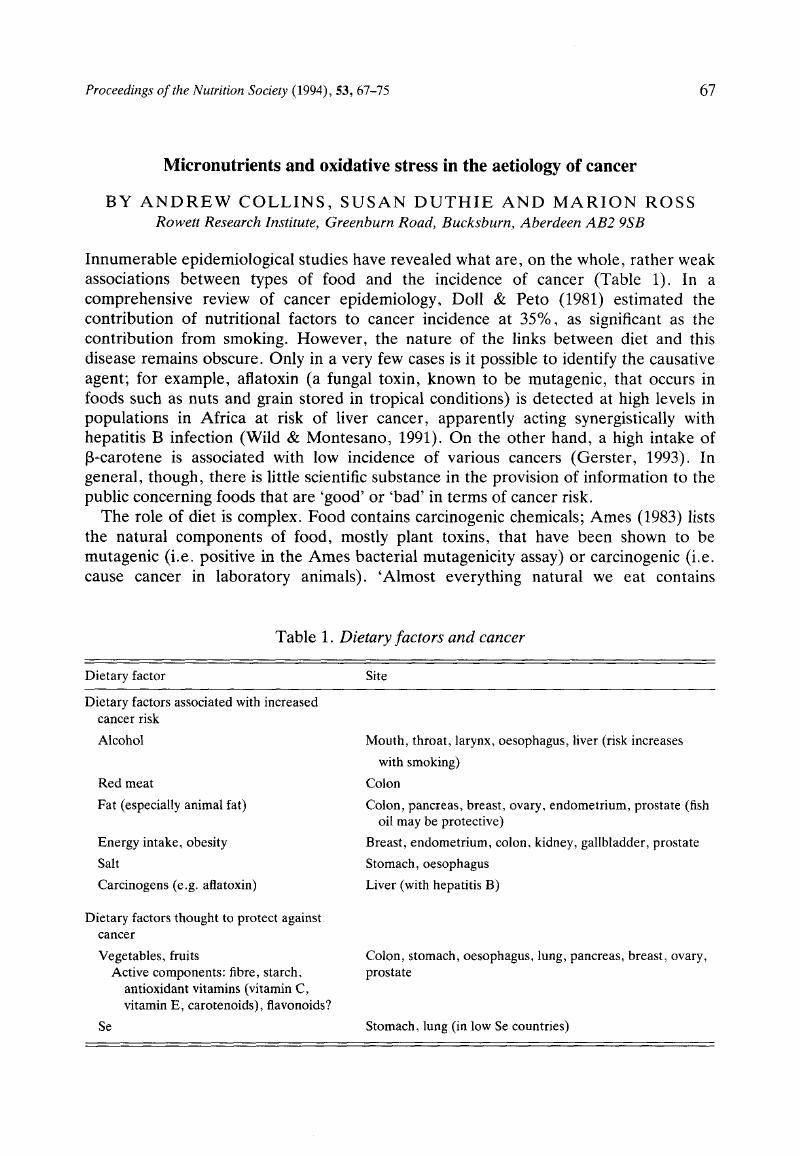Crossref Citations
This article has been cited by the following publications. This list is generated based on data provided by Crossref.
Enwonwu, C.O.
and
Meeks, V.I.
1995.
Bionutrition and Oral Cancer in Humans.
Critical Reviews in Oral Biology & Medicine,
Vol. 6,
Issue. 1,
p.
5.
Levander, Orville A.
Ager, Arba L.
and
Beck, Melinda A.
1995.
Vitamin E and selenium: contrasting and interacting nutritional determinants of host resistance to parasitic and viral infections.
Proceedings of the Nutrition Society,
Vol. 54,
Issue. 2,
p.
475.
Koratkar, Revati
and
Rao, A. Venketeshwer
1997.
Effect of soya bean saponins on azoxymethane‐induced preneoplastic lesions in the colon of mice.
Nutrition and Cancer,
Vol. 27,
Issue. 2,
p.
206.
BOLLENGIER-LEE, S.
MITCHELL, M. A.
UTOMO, D. B.
WILLIAMS, P. E. V.
and
WHITEHEAD, C. C.
1998.
Influence of high dietary vitamin E supplementation on egg production and plasma characteristics in hens subjected to heat stress.
British Poultry Science,
Vol. 39,
Issue. 1,
p.
106.
Augustin, Livia S.A.
Gallus, Silvano
Bosetti, Cristina
Levi, Fabio
Negri, Eva
Franceschi, Silvia
Dal Maso, Luigino
Jenkins, David J.A.
Kendall, Cyril W.C.
and
La Vecchia, Carlo
2003.
Glycemic index and glycemic load in endometrial cancer.
International Journal of Cancer,
Vol. 105,
Issue. 3,
p.
404.
Premkumar, K.
Abraham, Suresh K.
Santhiya, S. T.
and
Ramesh, A.
2003.
Protective effects of saffron (Crocus sativus Linn.) on genotoxins‐induced oxidative stress in Swiss albino mice.
Phytotherapy Research,
Vol. 17,
Issue. 6,
p.
614.
Hershkovich, Oded
Oliva, Jorge
and
Nagler, Rafael M
2004.
Lethal synergistic effect of cigarette smoke and saliva in an in vitro model: does saliva have a role in the development of oral cancer?.
European Journal of Cancer,
Vol. 40,
Issue. 11,
p.
1760.
Reznick, A Z
Hershkovich, O
and
Nagler, R M
2004.
Saliva – a pivotal player in the pathogenesis of oropharyngeal cancer.
British Journal of Cancer,
Vol. 91,
Issue. 1,
p.
111.
Hasnis, Erez
Reznick, Abraham Z.
Pollack, Shimon
Klein, Yfat
and
Nagler, Rafael M.
2004.
Synergistic effect of cigarette smoke and saliva on lymphocytes—the mediatory role of volatile aldehydes and redox active iron and the possible implications for oral cancer.
The International Journal of Biochemistry & Cell Biology,
Vol. 36,
Issue. 5,
p.
826.
Ben-Izhak, Ofer
Kablan, Fares
Laster, Zvi
and
Nagler, Rafael M.
2005.
Oropharyngeal cancer pathogenesis: Ubiquitin proteolytic, apoptotic and epidermal growth factor related pathways act in concert—first report.
Oral Oncology,
Vol. 41,
Issue. 8,
p.
851.
Hershkovich, O.
Shafat, I.
and
Nagler, R. M.
2007.
Age-Related Changes in Salivary Antioxidant Profile: Possible Implications for Oral Cancer.
The Journals of Gerontology Series A: Biological Sciences and Medical Sciences,
Vol. 62,
Issue. 4,
p.
361.
Greabu, Maria
Totan, Alexandra
Battino, Maurizio
Mohora, Maria
Didilescu, Andreea
Totan, Cosmin
and
Spinu, Tudor
2008.
Cigarette smoke effect on total salivary antioxidant capacity, salivary glutathione peroxidase and gamma‐glutamyltransferase activity.
BioFactors,
Vol. 33,
Issue. 2,
p.
129.
Hamsa, T. P.
and
Kuttan, Girija
2011.
Protective role of Ipomoea obscura (L.) on cyclophosphamide-induced uro- and nephrotoxicities by modulating antioxidant status and pro-inflammatory cytokine levels.
Inflammopharmacology,
Vol. 19,
Issue. 3,
p.
155.
Sirajudeen, M.
Gopi, Kandasamy
Tyagi, Jagbir Singh
Moudgal, Ram Phal
Mohan, Jag
and
Singh, Ram
2011.
Protective effects of melatonin in reduction of oxidative damage and immunosuppression induced by aflatoxin B1‐contaminated diets in young chicks.
Environmental Toxicology,
Vol. 26,
Issue. 2,
p.
153.
Nagle, Christina M.
Olsen, Catherine M.
Ibiebele, Torukiri I.
Spurdle, Amanda B.
and
Webb, Penelope M.
2013.
Glycemic index, glycemic load and endometrial cancer risk: results from the Australian National Endometrial Cancer study and an updated systematic review and meta-analysis.
European Journal of Nutrition,
Vol. 52,
Issue. 2,
p.
705.
Nayak, Balunkeswar
De J. Berrios, Jose
and
Tang, Juming
2014.
Impact of food processing on the glycemic index (GI) of potato products.
Food Research International,
Vol. 56,
Issue. ,
p.
35.
Yilmaz, Seval
Kaya, Emre
Karaca, Aysegul
and
Karatas, Ozhan
2018.
Aflatoxin B1 induced renal and cardiac damage in rats: Protective effect of lycopene.
Research in Veterinary Science,
Vol. 119,
Issue. ,
p.
268.





